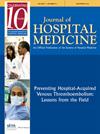协作开发基于规则的居家医院资格电子健康记录算法。
IF 2.3
4区 医学
Q1 MEDICINE, GENERAL & INTERNAL
引用次数: 0
摘要
广泛的住院人口、住院的动态性质以及进入护理模式的资格窗口对确定适合家庭医院(HaH)的患者提出了挑战。本研究提出了一种基于规则的算法(RBA)的开发,该算法利用电子健康记录(EHR)数据来改进HaH患者识别,这对于高效的HaH操作至关重要。RBA调整纳入了临床医生的反馈,以调整分析资源并增强临床工作流程。我们的研究强调了跨学科合作的重要性和分析的潜力,以优化新兴护理模式的效率。本文章由计算机程序翻译,如有差异,请以英文原文为准。

Collaborative development of a rules-based electronic health record algorithm for Hospital-at-Home eligibility
Identifying appropriate patients for hospital at Home (HaH) is challenged by the extensive inpatient population, the dynamic nature of hospitalizations, and the eligibility window for entry into the care model. This study presents the development of a rules-based algorithm (RBA) leveraging electronic health record (EHR) data to improve HaH patient identification, which is crucial for efficient HaH operations. RBA adjustments incorporated clinician feedback to align analytics resources and enhance clinical workflows. Our study highlights the importance of interdisciplinary collaboration and the potential for analytics to optimize efficiency for emerging care models.
求助全文
通过发布文献求助,成功后即可免费获取论文全文。
去求助
来源期刊

Journal of hospital medicine
医学-医学:内科
CiteScore
4.40
自引率
11.50%
发文量
233
审稿时长
4-8 weeks
期刊介绍:
JHM is a peer-reviewed publication of the Society of Hospital Medicine and is published 12 times per year. JHM publishes manuscripts that address the care of hospitalized adults or children.
Broad areas of interest include (1) Treatments for common inpatient conditions; (2) Approaches to improving perioperative care; (3) Improving care for hospitalized patients with geriatric or pediatric vulnerabilities (such as mobility problems, or those with complex longitudinal care); (4) Evaluation of innovative healthcare delivery or educational models; (5) Approaches to improving the quality, safety, and value of healthcare across the acute- and postacute-continuum of care; and (6) Evaluation of policy and payment changes that affect hospital and postacute care.
 求助内容:
求助内容: 应助结果提醒方式:
应助结果提醒方式:


